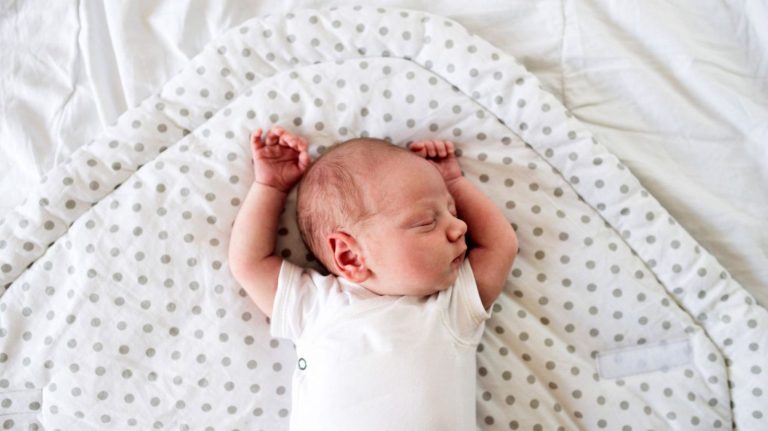
How to Create a Baby Sleep Routine That Actually Works?
- Created:
13. 5. 2025 - Updated:
14. 5. 2025
If you’re feeling like bedtime is a nightly mystery, you’re not alone. Babies aren’t born knowing the difference between day and night—or how to fall asleep on their own.
The good news?
You can teach them. Learning how to create a baby sleep routine that actually works is one of the most rewarding things you can do for your child—and your own sanity.
Let’s break down how to build a routine that fits your family, supports your baby’s sleep needs, and helps you all get more rest.
Why a Baby Sleep Routine Matters
Babies love predictability. A simple, consistent sleep routine helps them feel safe, secure, and relaxed before bed. And when bedtime feels familiar, it’s easier for your baby to fall—and stay—asleep.
A well-established sleep routine:
- Reduces fussiness and overtiredness
- Helps your baby recognize when it’s time to sleep
- Supports longer stretches of sleep (hello, rest!)
- Creates calming cues your baby will learn to trust
When to Start a Baby Sleep Routine
So, when should you start? The answer: gently, and sooner than you might think.
Around 6 to 8 weeks, babies start to develop more regular sleep-wake cycles. That’s a great time to begin introducing consistent cues—even if full nights of sleep are still a way off.
Look for signs your baby might be ready:
- Their naps start to follow a pattern
- They show clear sleep cues (like rubbing eyes or getting cranky)
- You’re feeling ready for a little more structure!
Key Ingredients of a Successful Baby Sleep Routine
Here’s what to focus on when learning how to create a baby sleep routine:
1. A Consistent Bedtime
Pick a bedtime between 6:30–8:00 p.m., depending on your baby’s age. Try to stick with it, even on weekends.
2. A Calm, Predictable Wind-Down
Your routine might look like this:
- Bath
- Diaper and pajamas
- Feeding
- A short lullaby or story
- Rocking or cuddlesThe goal is to signal to your baby: “Hey, it’s time to sleep.”
3. A Sleep-Friendly Environment
Set the scene:
- Dim lights
- White noise
- Room temperature around 68–72°F (20–22°C)
- Crib or bassinet with a firm, flat mattress
4. Feeding Before Bed
A gentle feeding session can help your baby feel full and relaxed, but try not to feed them to sleep every night—it’s helpful if they learn to fall asleep on their own.
5. Recognize Sleep Cues
Watch for signs like:
- Eye rubbing
- Yawning
- Turning away or losing interest
- Fussiness
Once you spot them, start the bedtime routine right away—before your baby becomes overtired.
Step-by-Step: How to Create a Baby Sleep Routine
Here’s your simple plan:
Step 1: Choose Your Bedtime
Stick with the same bedtime daily. Babies do best with consistency.
Step 2: Create a Short Routine (20–30 Minutes Max)
Do the same activities in the same order every night. Keep it calm, quiet, and predictable.
Step 3: Time Naps During the Day
Use age-appropriate wake windows:
- 0–3 months: 45–90 mins
- 4–6 months: 1.5–2.5 hours
- 6–9 months: 2–3 hours
- 9–12 months: 2.5–3.5 hoursGood naps = better night sleep.
Step 4: Keep the Sleep Environment Consistent
Use the same sleep space for naps and nighttime when possible.
Step 5: Be Consistent With Night Wakings
If you’re offering feedings at night, try to keep lights dim and stimulation low. Reassure your baby, but avoid full play sessions in the middle of the night.
Sample Baby Sleep Routines by Age
Here are quick examples of how routines evolve:
Newborn (0–3 Months)
- Bedtime: Around 9–10 p.m.
- Routine: Diaper → Pajamas → Feeding → Rocking or Cuddles
- Expect frequent night waking
4–6 Months
- Bedtime: 7:00–8:00 p.m.
- Routine: Bath → Pajamas → Feeding → Lullaby → Bed
- Naps: 3 per day
7–12 Months
- Bedtime: 6:30–7:30 p.m.
- Routine: Shorter, calming steps
- Naps: 2 per day
💡How much sleep does your baby need? Baby sleep schedule MONTH by MONTH.
What to Do When Routines Get Disrupted
Even the best routines hit bumps. Here’s how to stay on track:
- Sleep regressions? Stick to the routine as much as possible—this phase will pass.
- Teething or illness? Comfort your baby but try not to change the bedtime structure too much.
- Travel or time changes? Adjust slowly, sticking to your core routine.
Helpful Tools to Support Your Routine
Creating a baby sleep routine is easier with the right tools. Try:
- White noise machines
- Blackout curtains
- Sleep sacks or swaddles
- Video baby monitor (like the Annie Baby Monitor – perfect for keeping an eye without waking your baby)
Final Tips for Long-Term Success
- Keep routines simple: No need for complicated steps—your baby craves repetition, not production value.
- Be flexible: Your baby’s needs will change. Adjust bedtimes and routines as they grow.
- Give it time: Sleep routines don’t work overnight, but with consistency, they absolutely pay off.
FAQ: How to Create a Baby Sleep Routine?
The 5-3-3 rule suggests a baby sleeps for 5 hours at night, wakes for a 3-hour stretch, then sleeps another 3 hours—often used for managing newborn sleep patterns.
You can start a simple bedtime routine as early as 6 to 8 weeks old to help your baby learn sleep cues.
The 5-8-5 rule is a feeding schedule: 5 oz in the morning, 8 oz in the afternoon, and 5 oz at night—commonly used to manage formula intake for older infants.
The 2/3/4 rule spaces naps by 2 hours after waking, 3 hours after the first nap, and 4 hours before bedtime—usually for babies around 6–9 months.
Conclusion
Figuring out how to create a baby sleep routine that actually works takes time, trial, and a bit of patience—but it’s completely doable. And once it clicks? Your baby sleeps better. You sleep better. Everyone wins.
Ready to get started? Build a simple routine tonight and give it a few days. You might be surprised how quickly your baby starts to recognize the signs and settle in.






